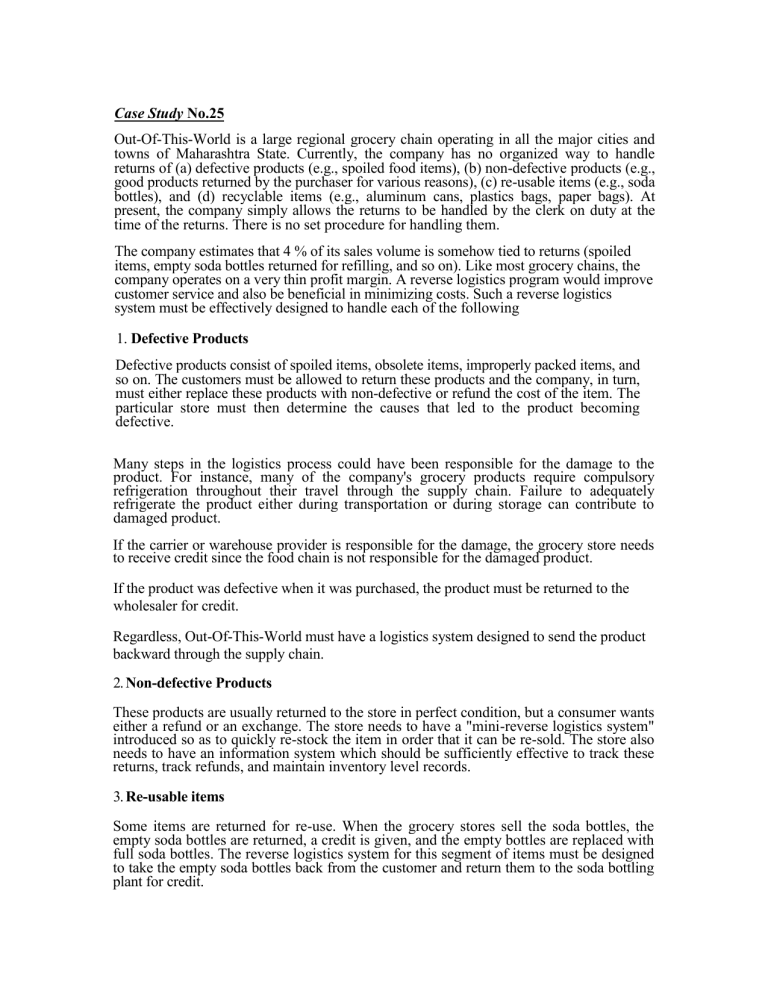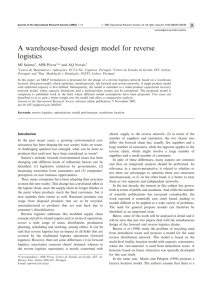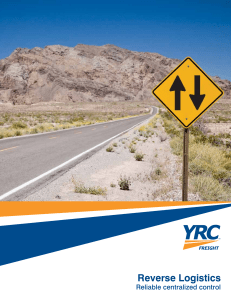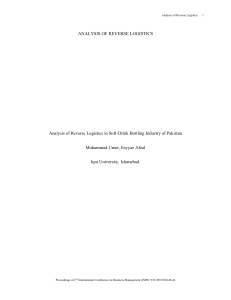Case Study No

Case Study No.25
Out-Of-This-World is a large regional grocery chain operating in all the major cities and towns of Maharashtra State. Currently, the company has no organized way to handle returns of (a) defective products (e.g., spoiled food items), (b) non-defective products (e.g., good products returned by the purchaser for various reasons), (c) re-usable items (e.g., soda bottles), and (d) recyclable items (e.g., aluminum cans, plastics bags, paper bags). At present, the company simply allows the returns to be handled by the clerk on duty at the time of the returns. There is no set procedure for handling them.
The company estimates that 4 % of its sales volume is somehow tied to returns (spoiled items, empty soda bottles returned for refilling, and so on). Like most grocery chains, the company operates on a very thin profit margin. A reverse logistics program would improve customer service and also be beneficial in minimizing costs. Such a reverse logistics system must be effectively designed to handle each of the following
1. Defective Products
Defective products consist of spoiled items, obsolete items, improperly packed items, and so on. The customers must be allowed to return these products and the company, in turn, must either replace these products with non-defective or refund the cost of the item. The particular store must then determine the causes that led to the product becoming defective.
Many steps in the logistics process could have been responsible for the damage to the product. For instance, many of the company's grocery products require compulsory refrigeration throughout their travel through the supply chain. Failure to adequately refrigerate the product either during transportation or during storage can contribute to damaged product.
If the carrier or warehouse provider is responsible for the damage, the grocery store needs to receive credit since the food chain is not responsible for the damaged product.
If the product was defective when it was purchased, the product must be returned to the wholesaler for credit.
Regardless, Out-Of-This-World must have a logistics system designed to send the product backward through the supply chain.
2. Non-defective Products
These products are usually returned to the store in perfect condition, but a consumer wants either a refund or an exchange. The store needs to have a "mini-reverse logistics system" introduced so as to quickly re-stock the item in order that it can be re-sold. The store also needs to have an information system which should be sufficiently effective to track these returns, track refunds, and maintain inventory level records.
3. Re-usable items
Some items are returned for re-use. When the grocery stores sell the soda bottles, the empty soda bottles are returned, a credit is given, and the empty bottles are replaced with full soda bottles. The reverse logistics system for this segment of items must be designed to take the empty soda bottles back from the customer and return them to the soda bottling plant for credit.
4. Recyclable items
The store is also interested in contributing to the environmental consciousness of local communities. The store wants to implement a reverse logistics system designed to collect aluminum cans, newspapers, glass containers, plastics items, and so on.
Questions:
Out-Of-This-World has appointed you to help the company in designing a reverse logistics system that will successfully handle the demands of the grocery chain. The system must achieve sufficient customer service levels, minimize costs, provide accurate record keeping of return items, and update information to maintain correct inventory levels.
Your report should also include a graphical representation of one or more reverse logistics systems required by the company.
You should also include in your report detailed description physical flows and information flows of items traveling through the reverse logistics system.
Lastly, your report should a detailed and concrete plan relating to an effective transportation, warehousing, and material handling system which should fit into the total systems and total cost concept of the company.









